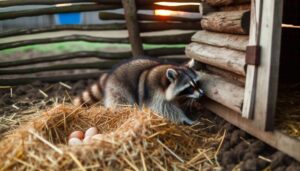How Do Raccoons Eat Rat Poison and Stay Safe?
Raccoons, with their omnivorous and opportunistic feeding behaviors, can indeed consume rat poison if drawn to it by appealing bait formulations. These baits often contain attractants such as sweeteners, oils, or scents that appeal to raccoons' keen sense of smell and taste.
Ingesting rat poison can lead to severe poisoning symptoms in raccoons, including behavioral changes and long-term health impacts. This not only affects individual raccoons but also poses broader environmental risks.
For humane pest control, consider live trapping, natural repellents, and exclusion techniques. Discover the importance of eco-friendly rodent control practices to safeguard both wildlife and the environment.
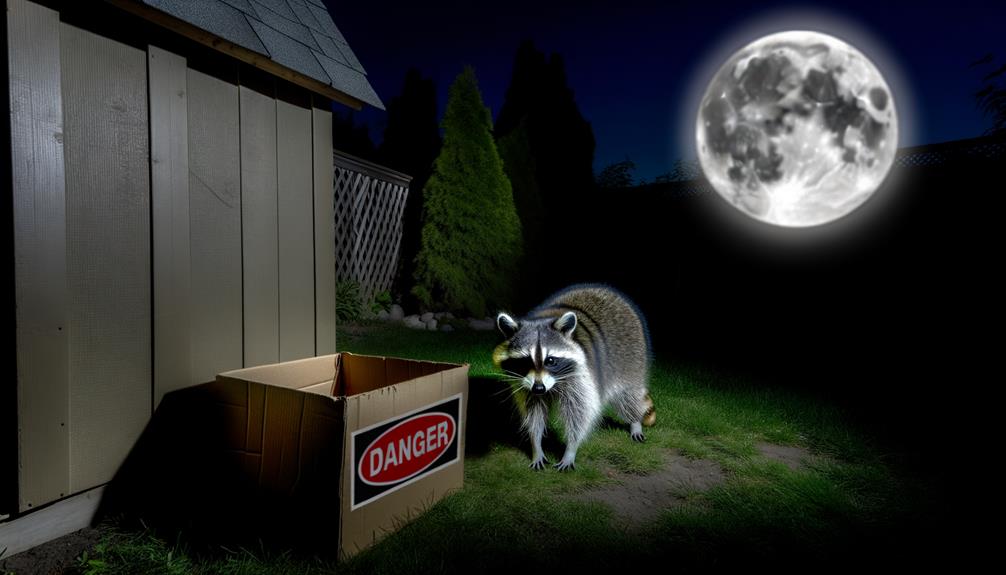
Key Takeaways
- Raccoons are omnivorous and have an opportunistic feeding behavior, making them likely to consume rat poison if encountered.
- Rat poisons often contain scent, flavor enhancements, sweeteners, and oils that can attract raccoons.
- Raccoons have a keen sense of smell and taste, which can lead them to ingest rat poison.
- Ingestion of rat poison by raccoons can cause severe health issues and symptoms requiring immediate veterinary care.
- Safe rodent control practices, including mechanical traps and natural repellents, can help prevent raccoons from accessing harmful poisons.
Raccoon Diet Overview
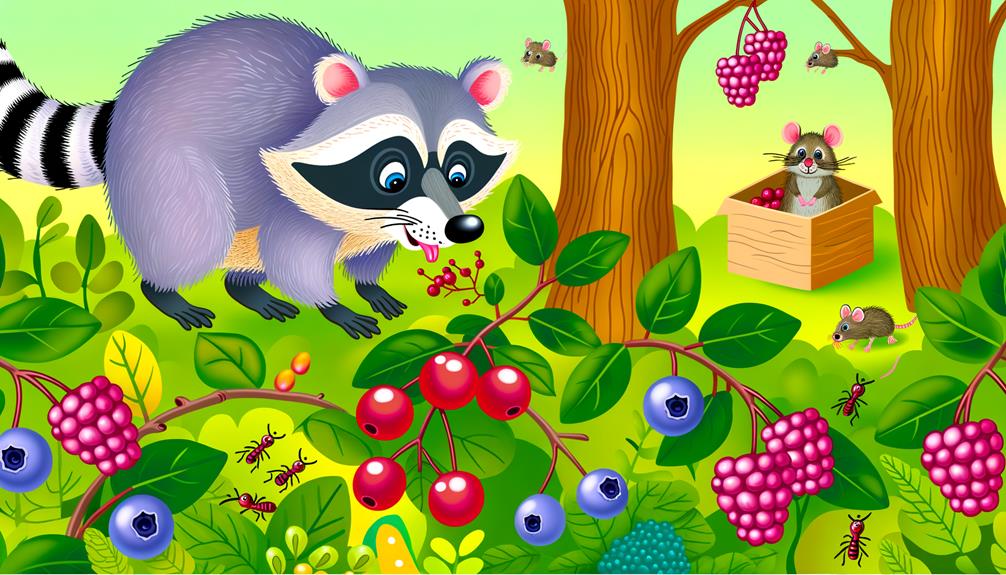
Raccoons are omnivorous mammals whose diet consists of a diverse range of foods including fruits, nuts, insects, small animals, and human refuse. Their opportunistic feeding behavior allows them to adapt to various environments, from urban to rural settings.
Studies indicate that their diet is seasonally variable; for instance, fruits and nuts are mainly consumed in autumn, while insects and small vertebrates are more common in spring and summer. Analysis of raccoon scat samples further confirms their dietary flexibility, showing a mix of plant and animal matter.
This dietary adaptability is essential for their survival, allowing them to exploit a wide array of food sources. Understanding raccoon dietary patterns is vital when considering their interactions with human environments and potential exposure to harmful substances.
Common Rat Poisons
Common rat poisons, also known as rodenticides, typically contain active ingredients such as anticoagulants, neurotoxins, or cholecalciferol, each designed to effectively eliminate rodent populations. These substances work through various mechanisms to ensure the eradication of pests.
- Anticoagulants: Prevent blood clotting, leading to internal bleeding and death.
- Neurotoxins: Disrupt the nervous system of rodents, causing paralysis and respiratory failure.
- Cholecalciferol: Increases calcium levels in the blood, resulting in organ failure.
- Bromethalin: Induces cerebral edema and vacuolization, leading to neurological impairment and death.
Understanding the specific action of these rodenticides is essential for evaluating their impact on non-target species and the environment. Each type of poison has distinct metabolic pathways and toxicological profiles, necessitating careful consideration in their application.
Attraction to Rat Poison
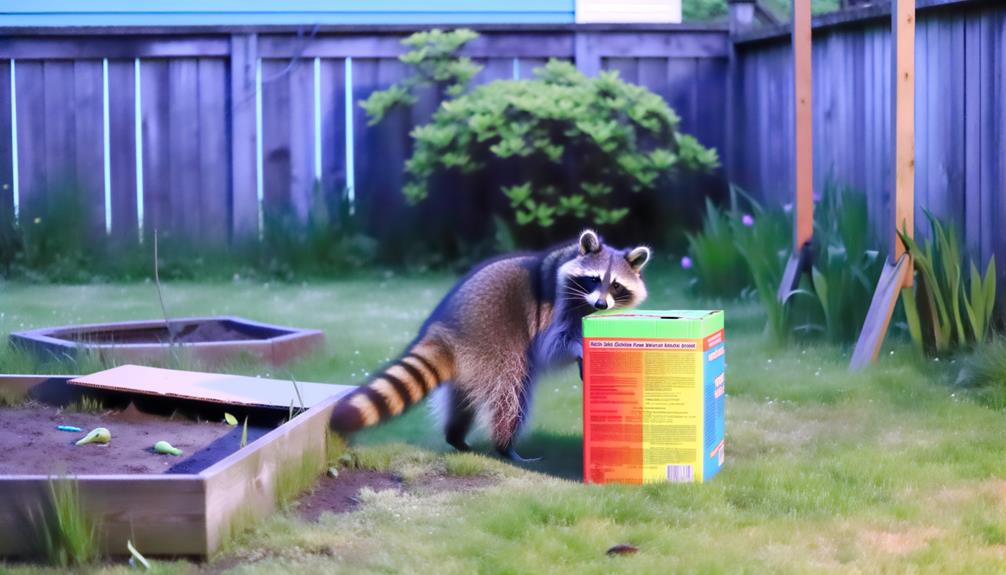
The attractiveness of rat poison to non-target species, including raccoons, hinges on several factors such as the bait formulation, scent, and flavor enhancements designed to lure rodents. Studies indicate that some rodenticides contain sweeteners, oils, and other additives that can inadvertently appeal to raccoons. These animals possess a keen sense of smell and taste, making them susceptible to consuming baits not intended for them.
Additionally, raccoons are opportunistic feeders with varied diets, increasing the likelihood of encountering and ingesting such poisons. Research has shown that approximately 15% of non-target wildlife fatalities due to rodenticides involve raccoons, underscoring the unintended consequences of these substances. Understanding bait attractiveness is vital for mitigating risks to non-target species.
Signs of Poison Ingestion
When raccoons ingest rat poison, they exhibit distinct behavioral changes such as lethargy and disorientation. Physical symptoms, including bleeding from openings and difficulty breathing, can also manifest.
Immediate veterinary intervention is essential to mitigate the severe, often fatal, effects of the toxin.
Behavioral Changes Observed
Observable behavioral changes in raccoons that have ingested rat poison include lethargy, disorientation, and uncoordinated movements. These signs are indicative of neurotoxic effects commonly associated with anticoagulant rodenticides. Such behavioral anomalies can be quantitatively assessed through careful observation.
Key behavioral changes include:
- Lethargy: Reduced physical activity and prolonged periods of inactivity.
- Disorientation: Difficulty in finding way around familiar environments, often appearing confused.
- Uncoordinated Movements: Lack of motor control, resulting in stumbling or falling.
- Reduced Fear Response: Decreased wariness towards humans and predators, which is atypical for raccoons.
These observations are critical for early detection and intervention, thereby mitigating further toxicological damage. Understanding these behavioral changes enables effective monitoring and timely medical response.
Physical Symptoms Manifested
In raccoons that have ingested rat poison, physical symptoms such as internal bleeding, pale gums, and hematomas are commonly manifested. These symptoms result from the anticoagulant properties of many rat poisons, which interfere with the blood's clotting mechanisms.
Internal bleeding may be observed through the presence of blood in the stool or urine, while pale gums indicate anemia caused by blood loss. Hematomas, or localized collections of blood outside the blood vessels, can appear as bruising or swelling under the skin.
Additional signs may include lethargy, weakness, and difficulty breathing, all of which stem from compromised circulatory function. Observing these symptoms in raccoons necessitates prompt medical evaluation to mitigate the toxic effects.
Immediate Veterinary Actions
Upon identifying signs of rat poison ingestion in raccoons, immediate veterinary intervention is vital to prevent fatal outcomes. Rapid diagnosis and treatment can help lessen the severe effects of the toxic substances.
Key steps include:
- Inducing Vomiting: This is often done if the ingestion occurred within the last few hours.
- Activated Charcoal Administration: To absorb any remaining poison in the gastrointestinal system.
- Vitamin K Injection: Important for counteracting anticoagulant rodenticides, which impair blood clotting.
- Supportive Care: Includes intravenous fluids, blood transfusions, or oxygen therapy depending on the severity of symptoms.
These measures are essential for stabilizing the raccoon and preventing long-term damage. Timely and appropriate veterinary care greatly improves the chances of recovery in affected raccoons.
Health Effects on Raccoons

Ingesting rat poison can lead to acute symptoms in raccoons such as internal bleeding, lethargy, and seizures. Data indicates that long-term exposure may result in chronic health issues, including organ damage and impaired reproductive capabilities.
These effects underscore the significant risks posed by rodenticides to raccoon populations.
Poisoning Symptoms Observed
Raccoons exposed to rat poison often exhibit symptoms such as lethargy, internal bleeding, and organ damage, which can be attributed to the anticoagulant properties of the toxins. These poisons hinder the blood's ability to clot, leading to significant health issues.
Observed symptoms of poisoning in raccoons include:
- Lethargy: A noticeable decrease in activity levels.
- Internal Bleeding: Evident through blood in feces or urine.
- Organ Damage: Particularly affecting the liver and kidneys.
- Excessive Bruising: Due to impaired blood clotting mechanisms.
The severity of these symptoms depends on the dosage and duration of exposure. Immediate veterinary intervention is essential to mitigate these adverse effects and improve the likelihood of recovery.
Long-term Health Impact
Understanding the long-term health impact of rat poison on raccoons requires examining the chronic physiological and biochemical changes induced by prolonged exposure to anticoagulant toxins. Studies indicate that these substances lead to persistent internal bleeding, impaired blood clotting mechanisms, and liver damage in affected raccoons.
Chronic exposure compromises their immune system, increasing susceptibility to infections. Additionally, bioaccumulation of toxins can result in reproductive challenges, such as reduced fertility and congenital abnormalities in offspring. Data-driven research highlights significant alterations in hematological parameters, including decreased red blood cell counts and hemoglobin levels.
These cumulative effects underscore the profound and enduring harm that anticoagulant rodenticides inflict on raccoons, with implications for both individual health and population dynamics.
Secondary Poisoning Risks
Secondary poisoning risks arise when raccoons consume rodents that have ingested rat poison, leading to the potential accumulation of toxic substances within the raccoon's system. This phenomenon is particularly concerning for wildlife health and biodiversity.
Studies indicate that secondary poisoning can result in various adverse effects in raccoons, including:
- Neurological damage: Impaired motor function and behavioral changes.
- Hematological issues: Reduced blood clotting ability, leading to internal bleeding.
- Reproductive problems: Lower fertility rates and developmental issues in offspring.
- Mortality: Increased likelihood of death due to cumulative toxicity.
Quantitative research underscores the need for integrated pest management strategies that minimize the use of toxic rodenticides to protect non-target species like raccoons. This approach safeguards a balanced ecosystem and reduces unintended harm.
Environmental Impact
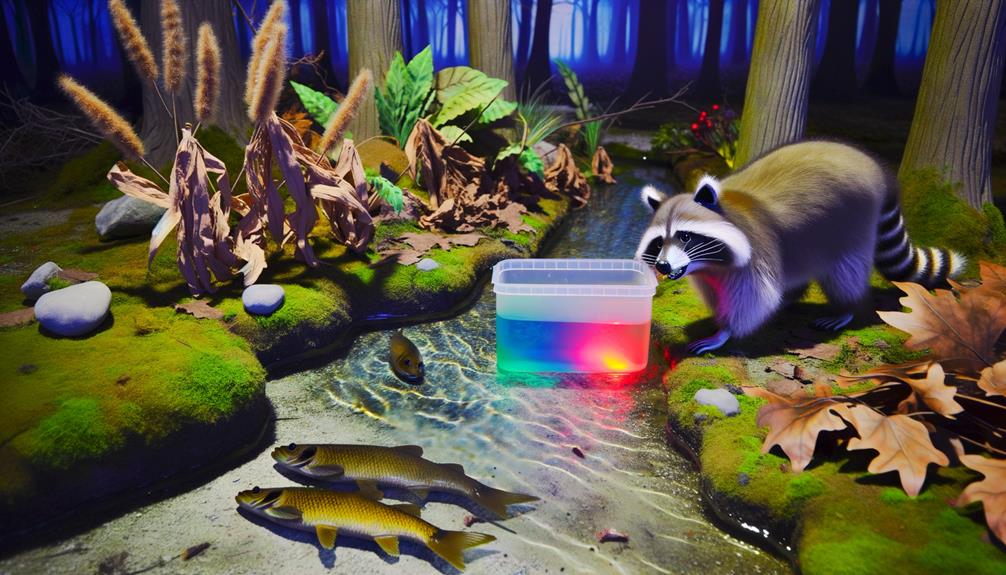
The pervasive use of rodenticides not only jeopardizes the health of individual raccoons through secondary poisoning but also poses significant threats to broader ecological systems. Rodenticides can infiltrate soil and water sources, affecting a myriad of non-target species and leading to a cascade of detrimental effects on biodiversity.
| Impact | Affected Species | Consequences |
|---|---|---|
| Secondary Poisoning | Raccoons, birds of prey | Mortality, reproductive issues |
| Soil Contamination | Invertebrates, plants | Disruption of soil health, plant growth |
| Water Contamination | Aquatic life, amphibians | Decline in populations, ecosystem health |
These disruptions highlight the urgent need to reconsider widespread rodenticide use to safeguard environmental integrity.
Humane Pest Control Options
Humane pest control options offer effective strategies for managing raccoon populations without causing harm.
These methods include live trapping techniques, which allow for the safe relocation of raccoons, and natural repellents that discourage their presence through non-toxic means.
Additionally, exclusion techniques, such as sealing entry points, can prevent raccoons from accessing homes and other structures.
Live Trapping Methods
Utilizing live trapping methods for raccoon control offers a humane and effective alternative that minimizes harm to non-target species. These methods involve capturing raccoons in specially designed cages that allow for safe relocation. Scientific data supports live trapping as an ethical approach, reducing the likelihood of unintended ecological impacts.
Key considerations for implementing live trapping include:
- Proper Trap Selection: Choosing the right size and type of trap to guarantee humane capture.
- Baiting Techniques: Using bait that specifically attracts raccoons while avoiding other animals.
- Legal Compliance: Adhering to local wildlife regulations for capture and relocation.
- Post-Capture Handling: Ensuring minimal stress during transport and release in suitable habitats.
These strategies collectively enhance humane pest control efficacy and contribute to ecological balance.
Natural Repellent Solutions
In addition to live trapping methods, employing natural repellent solutions can further mitigate raccoon presence by leveraging non-toxic, environmentally friendly substances. Various substances have been studied for their efficacy in deterring raccoons without causing harm. The table below details some commonly used natural repellents, their active ingredients, and effectiveness.
| Repellent Type | Active Ingredient | Effectiveness (%) |
|---|---|---|
| Predator Urine | Synthetic Fox Urine | 75% |
| Capsaicin Spray | Capsaicin | 80% |
| Ammonia Soaked Rags | Ammonium Hydroxide | 65% |
| Garlic Spray | Allicin | 70% |
These repellents work by exploiting raccoons' aversion to certain smells and tastes, thereby providing humane and sustainable pest control options. Proper application and regular reapplication are essential for maintaining effectiveness.
Exclusion Techniques Explained
Effective exclusion techniques are pivotal in humane pest control, aiming to prevent raccoons from accessing specific areas without causing them harm. These methods rely on creating physical barriers or altering the environment to make it less inviting for raccoons.
Key exclusion techniques include:
- Sealing Entry Points: Identify and close gaps in attics, roofs, and basements with durable materials like metal flashing or hardware cloth.
- Installing Chimney Caps: Prevent raccoons from entering homes via chimneys by using secure, raccoon-proof caps.
- Fencing: Utilize electric or mesh fencing to protect gardens and other outdoor areas.
- Maintaining Cleanliness: Reduce attractants by securing trash bins and removing food sources.
These strategies are supported by data showcasing their effectiveness in reducing raccoon intrusions without adverse impacts on wildlife.
Raccoon-Proofing Tips
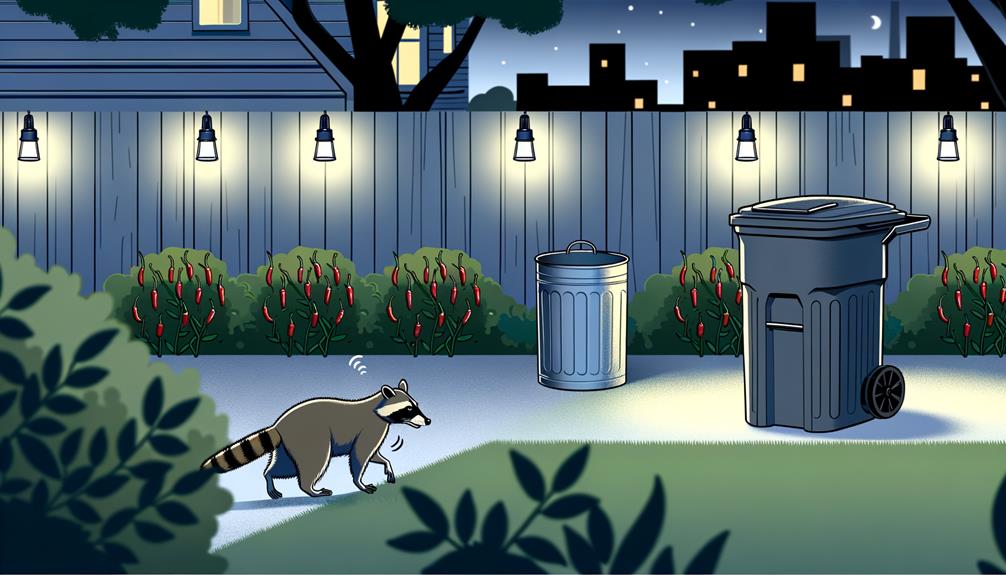
Implementing raccoon-proofing strategies involves securing potential food sources, sealing entry points, and using deterrents to minimize raccoon access to residential areas.
Data indicates raccoons are highly adaptable and opportunistic feeders, making accessible food a primary attractant. Secure trash cans with locking lids, and avoid leaving pet food outside.
Additionally, sealing entry points such as chimneys, vents, and gaps in roofing prevents nesting. Utilizing raccoon deterrents, such as motion-activated lights or sprinklers, can effectively reduce their presence.
Studies also suggest that employing physical barriers like fencing, at least 3 feet high and buried 6 inches deep, can deter raccoons. Regular maintenance and vigilant monitoring are critical in ensuring these measures remain effective.
Safe Rodent Control Practices
Adopting safe rodent control practices is crucial to mitigate the risk of secondary poisoning and ensure the safety of non-target wildlife, pets, and humans. Research indicates that traditional rodenticides pose significant threats to ecosystems and public health.
To guarantee efficient and safe rodent management, consider the following approaches:
- Mechanical traps: Utilize snap traps or electronic traps to avoid the use of harmful substances.
- Natural predators: Encourage the presence of natural rodent predators such as owls and hawks.
- Rodent-proofing: Seal entry points in buildings and eliminate food sources to prevent infestations.
- Eco-friendly baits: Use non-toxic baits that are specifically designed to target rodents without harming other species.
These methods not only protect the environment but also effectively control rodent populations.
Conclusion
The ingestion of rat poison by raccoons is a serious concern, posing significant health risks and environmental repercussions. Common rodenticides can attract these omnivores, leading to dire outcomes.
Recognizing symptoms of poisoning is essential for timely intervention. Employing humane pest control methods and raccoon-proofing measures can mitigate such risks.
Ultimately, a stitch in time saves nine; proactive strategies in pest management guarantee the well-being of raccoons and preserve ecological balance.





